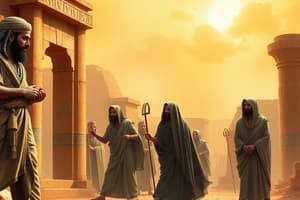Podcast
Questions and Answers
What were the chief exports of Mesopotamia?
What were the chief exports of Mesopotamia?
- Stone, timber and metal ores
- Cosmetics and perfumes
- Metal objects and gold ornaments
- Food grains and finished products
What was the primary occupation of the people of Mesopotamia?
What was the primary occupation of the people of Mesopotamia?
- Agriculture (correct)
- Domesticating animals
- Tutoring the children of their masters
- Accounting and arts and crafts
What was the purpose of building reservoirs in Mesopotamia?
What was the purpose of building reservoirs in Mesopotamia?
- To control flood from the Tigris and Euphrates rivers (correct)
- To store grains and finished products
- To irrigate the land
- To support trade and commerce
What is evident from the vast collection of metal objects found from the royal burial ground at Ur?
What is evident from the vast collection of metal objects found from the royal burial ground at Ur?
What was the occupation of some slaves in Mesopotamia?
What was the occupation of some slaves in Mesopotamia?
What did the people of Mesopotamia use to draw the plough and wheeled carts?
What did the people of Mesopotamia use to draw the plough and wheeled carts?
What did the people of Mesopotamia cultivate?
What did the people of Mesopotamia cultivate?
With which civilization did the Mesopotamians have trade relations?
With which civilization did the Mesopotamians have trade relations?
Flashcards are hidden until you start studying
Study Notes
Slavery in Mesopotamia
- Slaves were used to repay debts and were employed in households for maintaining and managing estates.
- They were also used for tutoring the children of their masters.
- Some slaves were engaged in other activities like accounting, arts, and crafts if their masters believed they had the talent.
Occupation and Agriculture
- The people of Mesopotamia were primarily engaged in agriculture.
- They developed an excellent system of irrigation to ensure a continuous supply of water.
- Reservoirs were built to control floods from the Tigris and Euphrates rivers.
- They used cattle to draw the plough and wheeled carts.
- They cultivated wheat, barley, fruits, and pulses.
- They also domesticated animals like cows, goats, sheep, and donkeys.
Eco-Friendliness of Occupations
- The occupations of the people of Mesopotamia were largely eco-friendly, relying on natural resources and traditional farming practices.
Arts and Crafts
- The people of Mesopotamia were skilled in art and craft, as evident from the vast collection of metal objects found from the royal burial ground at Ur.
- They acquired specialized skills in pottery-making, weaving, and metal work.
- They were skilled in bleaching, dyeing, preparation of paints, cosmetics, and perfumes.
- The discovery of seals, metal objects, gold and silver ornaments, statues, and pottery are all reminders of the Mesopotamian expertise in art and craft.
Trade and Commerce
- Trade and commerce flourished in Mesopotamia, making it a prosperous civilization.
- The chief exports were food grains and finished products.
- The chief imports were stone, timber, and metal ores.
- They traded with the Mediterranean countries and Egypt.
- They had trade relations with the Indus Valley Civilization, as evidence of Mesopotamian seals had been uncovered at some Indus Valley sites.
- They invented coins, weights, and measures to encourage trade and commerce.
- They were also the first people in the world to issue receipts and bills in business transactions.
Architecture and Technology
- The Mesopotamians introduced the use of arches, columns, and domes in their constructions.
- The Ziggurats and the Hanging Gardens represent the best example of Mesopotamian architecture.
- The Hanging Gardens of Babylon are one of the Seven Wonders of the ancient world and were built by King Nebuchadnezzar II for his wife.
- A ziggurat is a type of massive structure built in ancient Mesopotamia.
- Reservoirs were large natural or artificial lakes used as a source of water supply.
Studying That Suits You
Use AI to generate personalized quizzes and flashcards to suit your learning preferences.




